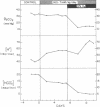Abstract
It is generally believed that the reduction in plasma [HCO3] characteristic of chronic hypocapnia results from renal homeostatic mechanisms designed to minimize the alkalemia produced by.the hypocapneic state. To test this hypothesis, we have induced chronic hypocapnia in dogs in which plasma [HCO3] had previously been markedly reduced (from 21 to 15 meq/liter) by the prolonged feeding of HCl. The PaCO2 of chronically acid-fed animals was reduced from 32 to 15 mm Hg by placing the animials in a large environmental chamber containing 9% oxygen. In response to this reduction in PaCO2, mean plasma [HCO3] fell by 8.6 meq/liter, reaching a new steady-state level of 6.4 meq/liter. This decrement in plasma [HCO3] is almost identical to the 8.1 meq/liter decrement previously observed in normal (nonacid-fed) animals in which the same degree of chronic hypocapnia had been induced. Thus, in both normal and HCl-fed animals, the renal response to chronic hypocapnia causes plasma [HCO3] to fall by approximately 0.5 meq/liter for each millimeter of Hg reduction in CO2 tension. By contrast, the response of plasma [H+] in the two groups was markedly different. Instead of the fall in [H+] which is seen during chronic hypocapnia in normal animals, [H+] in HCl-fed animals rose significantly from 53 to 59 neq/liter (pH 7.28-7.23). This seemingly paradoxical response is, of course, an expression of the constraints imposed by the Henderson equation and reflects the fact that the percent fall in [HCO3] in the HCl-fed animals was greater than the percent fall in PaCO2. These findings clearly indicate that in chronic hypocapnia the kidney cannot be regarded as the effector limb in a homeostatic feedback system geared to the defense of systemic acidity.
Full text
PDF






Images in this article
Selected References
These references are in PubMed. This may not be the complete list of references from this article.
- ADLER S., ROY A., RELMAN A. S. INTRACELLULAR ACID-BASE REGULATION. I. THE RESPONSE OF MUSCLE CELLS TO CHANGES IN CO2 TENSION OR EXTRACELLULAR BICARBONATE CONCENTRATION. J Clin Invest. 1965 Jan;44:8–20. doi: 10.1172/JCI105129. [DOI] [PMC free article] [PubMed] [Google Scholar]
- BRADLEY A. F., SEVERINGHAUS J. W., STUPFEL M. Accuracy of blood pH and PCO2 determinations. J Appl Physiol. 1956 Sep;9(2):189–196. doi: 10.1152/jappl.1956.9.2.189. [DOI] [PubMed] [Google Scholar]
- BRADLEY A. F., SEVERINGHAUS J. W., STUPFEL M. Variations of serum carbonic acid pK with pH and temperature. J Appl Physiol. 1956 Sep;9(2):197–200. doi: 10.1152/jappl.1956.9.2.197. [DOI] [PubMed] [Google Scholar]
- Brown E. B., Jr, Kim W. G., Moorhead F. A., Jr Intracellular pH during metabolic acidosis of intracellular and extracellular origin. Proc Soc Exp Biol Med. 1967 Nov;126(2):595–599. doi: 10.3181/00379727-126-32516. [DOI] [PubMed] [Google Scholar]
- De Sousa R. C., Harrington J. T., Ricanati E. S., Shelkrot J. W., Schwartz W. B. Renal regulation of acid-base equilibrium during chronic administration of mineral acid. J Clin Invest. 1974 Feb;53(2):465–476. doi: 10.1172/JCI107580. [DOI] [PMC free article] [PubMed] [Google Scholar]
- GULYASSY P. F., VAN YPERSELE DE STRIHOU C., SCHWARTZ W. B. On the mechanism of nitrate-induced alkalosis. The possible role of selective chloride depletion in acid-base regulation. J Clin Invest. 1962 Oct;41:1850–1862. doi: 10.1172/JCI104642. [DOI] [PMC free article] [PubMed] [Google Scholar]
- Gennari F. J., Goldstein M. B., Schwartz W. B. The nature of the renal adaptation to chronic hypocapnia. J Clin Invest. 1972 Jul;51(7):1722–1730. doi: 10.1172/JCI106973. [DOI] [PMC free article] [PubMed] [Google Scholar]
- Kassirer J. P., Schwartz W. B. The response of normal man to selective depletion of hydrochloric acid. Factors in the genesis of persistent gastric alkalosis. Am J Med. 1966 Jan;40(1):10–18. doi: 10.1016/0002-9343(66)90182-3. [DOI] [PubMed] [Google Scholar]
- NEEDLE M. A., KALOYANIDES G. J., SCHWARTZ W. B. THE EFFECTS OF SELECTIVE DEPLETION OF HYDROCHLORIC ACID ON ACID-BASE AND ELECTROLYTE EQUILIBRIUM. J Clin Invest. 1964 Sep;43:1836–1846. doi: 10.1172/JCI105057. [DOI] [PMC free article] [PubMed] [Google Scholar]
- POLAK A., HAYNIE G. D., HAYS R. M., SCHWARTZ W. B. Effects of chronic hypercapnia on electrolyte and acid-base equilibrium. I. Adaptation. J Clin Invest. 1961 Jul;40:1223–1237. doi: 10.1172/JCI104353. [DOI] [PMC free article] [PubMed] [Google Scholar]
- ROBIN E. D., BROMBERG P. A. Claude Bernard's milieu interieur extended: intracellular acid-base relationships. Am J Med. 1959 Nov;27:689–692. doi: 10.1016/0002-9343(59)90185-8. [DOI] [PubMed] [Google Scholar]
- Schwartz W. B., Silverman L. A large environmental chamber for the study of hypercapnia and hypoxia. J Appl Physiol. 1965 Jul;20(4):767–774. doi: 10.1152/jappl.1965.20.4.767. [DOI] [PubMed] [Google Scholar]
- Tannen R. L., Bleich H. L., Schwartz W. B. The renal response to acid loads in metabolic alkalosis; an assessment of the mechanisms regulating acid excretion. J Clin Invest. 1966 Apr;45(4):562–572. doi: 10.1172/JCI105370. [DOI] [PMC free article] [PubMed] [Google Scholar]



